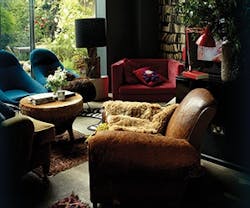8 Designers Going Their Own Way
London, England
Interior designer, author, retailer, and promoter of all things vintage, Abigail Ahern has changed the way we look at used (but beautiful) things. Drawing freely from past and present, her interiors blend plush textures and patterns from across stylistic boundaries, while her company’s lines of furnishings, wallpapers, textiles, and accessories offer the same optimistic, tongue-in-cheek aesthetic to the wider world. It’s all part of her mission to create a more interesting, varied world. “You should never be able to ‘read’ a space instantly,” Ahern told The Telegraph in January. “You design so that the eye is pulled in
different directions.”
Amsterdam, Netherlands
As the founder of Droog Design, Gjis Bakker helped to develop a unique style of design that mixes dry humor with a clean, experimental, and industrial aesthetic. Whether it’s a set of cutlery or seating for a museum café, Bakker has a knack for creating products that connect with our need for fun and functionality. He’s also a renowned teacher, with more than 40 years of experience in the Netherlands leading design schools, including the ArtEZ Institute for the Arts in Arnhem, the Delft University of Technology, and the Design Academy Eindoven, where he has taught hundreds of
up-and-coming designers to embrace and chase their most revolutionary designs—a
dedication worth more than one award.
Amsterdam, Netherlands
Soeters Van Eldonk is actually two people: Jos Van Eldonk and Sjoerd Soeters, both Dutch architects who have been working together for so long that, according to the judges, “they deserved to be awarded together.” The work of Soeters and Van Eldonk is both theoretical and deeply human—an experiment in form and a pragmatic response to the surrounding elements—and it has given them the opportunity to leverage their knowledge in everything from offices to cultural centers. “Cherished buildings are seldom refurbished, even when their functions change, and they are never demolished,” say the architects as a sort of credo. One suspects that Aalto would agree.
Helsinki, Finland
Japanese designer Nene Tsuboi and Finnish architect Tuomas Toivonen have made their mark by exploring the borders where architecture and design overlap. Between the two of them, their interests span interior, graphic, and furniture design,
and each of their building projects reflect that
with an expert combination of stories, visuals, objects, and whimsy. Tsuboi and Toivonen founded their architectural practice, NOW, in 2005 with the aim of “[making] the city and the world around us more interesting and
enjoyable.” Their
latest installation, a public sauna in the heart of Helsinki (shown), proves they’re on the right path.
Stockholm, Sweden
Visual artist and designer Kyuhyung Cho was born in South Korea but now spends his time in Stockholm, fusing European and Asian design motifs and researching the ways that objects can transform into one another. From his new SINE hanger system (shown), which echoes the form of a sound wave, to his Pictograph fonts, which invented a system of intricate images to represent individual letters, his work has the same qualities as Aalto’s—humble and simple, yet full of curiosity and humanity. “Very small and simple things in our everyday lives can be very beautiful when we make an effort to pay attention to them,” Cho said.
Cesena, Italy
Italian designer Marcantonio Raimondi Malerba got his start working in the theater, which helps explain why his products and spaces all seem to originate from a dream. He effortlessly layers childhood memories, outsized shapes, and surreal elements into his designs, giving his work a painterly, emotional feeling. As with Aalto, one of his favorite themes is the relationship between man and nature, and how what we think and expect affects the object in front of us. He also has a quirky sense of humor, and seeks to infuse it into everything he does. “I never give up irony; irony is a serious matter,” Malerba said. “If a good idea is also fun, I cannot resist realizing it.”
